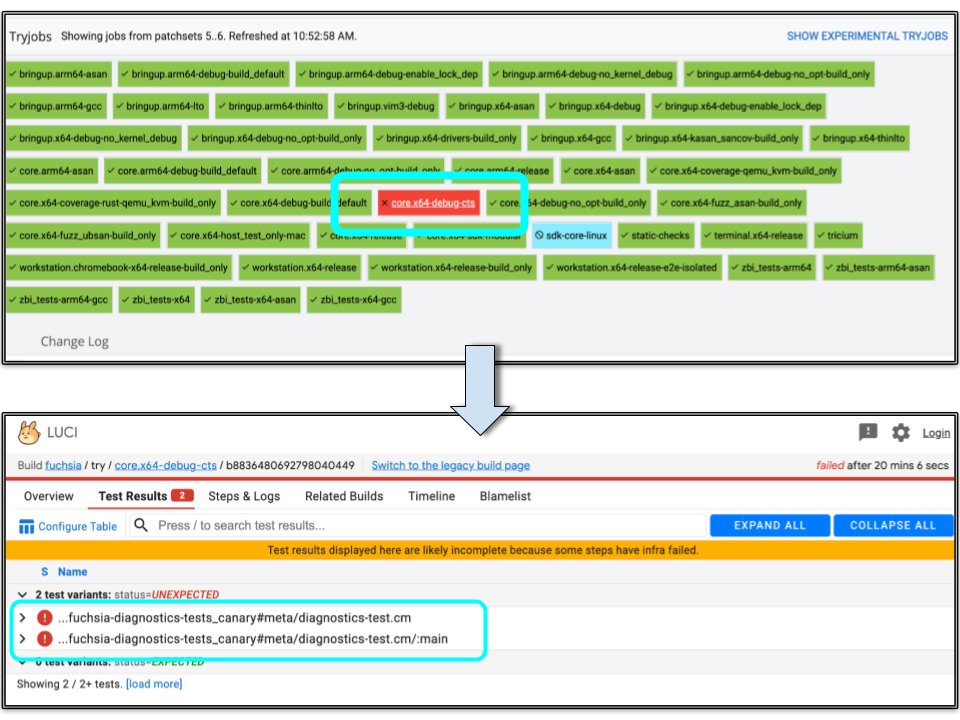The Fuchsia Platform Surface Area (PlaSA) is defined as the set of ABIs and APIs exposed by the Fuchsia SDK. It is critical to maintain compatibility between subsequent releases of the Fuchsia Platform in order to ensure existing products and applications continue to operate correctly.
The Compatibility Tests for Fuchsia (CTF) are one method of enforcing this compatibility. To learn more about how it works, please see the CTF RFC and the other pages on CTF in fuchsia.dev. This doc aims to help you understand what to do if a CTF test fails in Fuchsia CQ.
Understand how your CL has changed the Fuchsia PlaSA
First, try to understand what part of the PlaSA has changed. If you already know, proceed to the next section.
CTF tests are designed to target a small part of the Fuchsia platform. The name and location of the failing test should be a good indication of what changed. In general (but not always), CTF tests will mirror their location in the SDK directory. Here are a few examples:
| Tests located at ... | Are testing ... |
|---|---|
| //sdk/ctf/fidl/fuchsia.diagnostics | //sdk/fidl/fuchsia.diagnostics |
| //sdk/ctf/pkg/memfs | //sdk/lib/memfs |
| //sdk/ctf/tools/package_manager | //src/sys/pkg/bin/pm |
You can find the name of the failing test by clicking on the
core.x64-debug-cts builder, and switching to the Test Results tab.

If the name of the test gives no indication of what changed in the platform surface area, do a search of the CTF directory. The test code should live in a directory named after the PlaSA area it validates.
If all else fails, please feel free to reach out to the CTF team.
Once you've located the test code, you can use it to understand why your CL is causing it to fail. If it was an unintentional change, simply update your CL until the test no longer fails. If it was intentional, however, you have a couple of options on how to proceed:
- Perform a soft transition to the PlaSA
- Patch the test in all active CTF releases (WIP)
The sections below will describe these options in more detail.
Resolving the issue
Option 1: Perform a Soft Transition to the PlaSA
RFC-0002 describes our strategy for evolving the Fuchsia platform in a backwards-compatible way. Modifications to the public interface require a soft transition whenever possible: new elements are added, users of the old elements are migrated, then finally the old interface can be deprecated.
This is a multi-step process which may take weeks to complete. We are working to make this automatic and self-service, but please don't hesitate to reach out to the CTF team if you have any questions.
1) Add the new API and associated CTF tests
- Work with the API council to ensure this new API is ready for prime time.
- Consider writing new CTF tests to cover your new API in full.
- This will be a requirement in the future, and will help the Fuchsia Platform continue to evolve efficiently.
2) Deprecate the old API
- Work with the SDK team to identify any downstream customers of the old API.
- Work with the associated SDK integrators to migrate them to the new API.
- Finally, work with the CTF team to "pause" existing CTF tests.
- It may take weeks for the paused tests to be removed from all CTF releases in CQ (until the next major Fuchsia Platform release)
3) Remove the old API and associated CTF tests
- Once all CTF tests that touch the old API have been removed from the CTF releases, you can successfully delete the API at TOT.
Option 2: Patch the test in all active CTF releases (WIP)
If a given CTF test is testing too much (e.g. some internal implementation details), or some other unique situation requires modifying the Fuchsia PlaSA more frequently than the CTF release window supports, then the CTF tests in the active CTF releases will need to be modified.
Please reach out to the CTF team if this is required.
